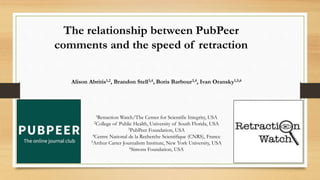
The relationship between PubPeer comments and the speed of retraction
- 1. The relationship between PubPeer comments and the speed of retraction Alison Abritis1,2, Brandon Stell3,4, Boris Barbour3,4, Ivan Oransky1,5,6 1Retraction Watch/The Center for Scientific Integrity, USA 2College of Public Health, University of South Florida, USA 3PubPeer Foundation, USA 4Centre National de la Recherche Scientifique (CNRS), France 5Arthur Carter Journalism Institute, New York University, USA 6Simons Foundation, USA
- 2. Disclosures • I am the volunteer co-founder of Retraction Watch, and volunteer executive director of The Center For Scientific Integrity, our parent 501(c)3 nonprofit organization. • I am on the board of directors of the PubPeer Foundation, a 501(c)3 nonprofit organization. • I am an employee of the Simons Foundation, where I am editor in chief of Spectrum. • I am an employee of New York University’s Arthur Carter Journalism Institute, where I serve as Distinguished Writer in Residence.
- 3. Why study time to retraction (TTR)? • Provides measure of the efficiency of correction of the literature • Long TTR allows for continued spread of poor or misleading information • Long TTR allows for continued citation of problematic research, and waste of resources What does previous research show? • A 2021 study by Guadino et al. gives median TTR of 657 days (1.8 years)2 • A 2012 study by Steen et al shows an average TTR of 987 days (32.91 months)1 • A 2021 study by Serghio et al. gives a median TTR of 457 days (1.3 years)3
- 4. “due to concerns with an undeclared splice identified in Figure 5(a), p-MYPT1, as originally raised on PubPeer [2].” PubPeer: Clearly part of the impetus for literature cleanup “As originally reported in https://pubpeer.com/publicatio ns/F4F79D78FA1249D847FBB6E A4B3381, Fig. 4E shows evidence of data manipulation,…”
- 5. Retraction Watch Database4: a database of retractions going back to 1756 and launched in 2018, created and maintained by Retraction Watch, a blog started in August 2010 addressing retractions and other issues in publishing and misconduct. Both are projects of The Center for Scientific Integrity, a U.S.-based 501(c)3 nonprofit organization. PubPeer5: a 501(c)3 nonprofit organization founded in October 2012; provides an online forum for readers and authors to discuss published articles. Sources of Information
- 6. Methods: Time Frame: Original date of article publication from January 1, 2015 through December 31, 2020, and entered into RWD by October 11, 2021 Original Data Source: Retraction Watch Database (RWD) Article Filters: Article Types (RWD Category) restricted to Research Articles, Clinical Studies, Case Reports, Review Articles (excluding book reviews) Subtotal Articles in Sample = 8,840 Eliminated Articles: inability to ascertain date of retraction: n = 466 Final Sample Article Total – 8,374
- 7. Methods PubPeer (PP) entries matched via DOIs: 1,923 Final Sample of PubPeer Entries for comparison: 1,174 PP entries made on or after article retraction: 749 PP entries made with critical comments: 1,923
- 8. Articles without PubPeer comments; retraction from date of publication (n = 7200) Articles with PubPeer comments; retraction from date of publication (n=1174) Articles with PubPeer comments; retraction from date of first PubPeer comment (n = 1174) Average TTR (days) 655.09 (sd = 461.53) 939.51 (sd = 446.30) 277.83 (sd = 171.88) Results
- 9. Findings: The TTR for articles without PP comments (655 days) is in the range of two more recent studies but shorter than study from 2012, when PubPeer first launched The overall TTR for articles with PP comments is on the higher end (939 days) of previous studies The TTR starting at the time of the PubPeer comment (278 days) is much shorter than the overall TTR of any previous studies
- 10. Conclusion: Limitations • As with any study, not every retracted article may have been captured in the search • Unable to determine TTR from non-published allegations to retraction Findings suggest that Internet platforms including PubPeer and social media create space for critical commentary not made previously visible PP commenting may have grown due to frustration with a lack of editorial responses, as suggested by lengthy overall TTR for papers with PP Findings suggest that journal and publishers have improved or made better use of their retraction protocols
- 11. References 2Guadino M, Robinson NB, Audisio K, Rahouma M, Benedetto U, Kurlansky P, Fremes SE. 2021. Trends and Characteristics of Retracted Articles in the Biomedical Literature, 1971 to 2020. JAMA Internal Medicine. 181(8):1118-1121. 1Steen RG, Casadevall A, Fang FC. 2012. Why Has the Number of Scientific Retractions Increased? PLoS One. 8(7): e68397. 4Retraction Watch Database: http://retractiondatabase.org/ 5PubPeer: https://pubpeer.com/ 3Serghiou S, Marton RM, Ioannidis JPA. 2021. Media and social media attention to retracted articles according to Altmetric. PLoS ONE 16(5): e0248625.
Editor's Notes
- Some Pubpeer Entries only noted that the article had been retracted, or comments as to problems were made after the article was already retracted. These were eliminated from the sample.
